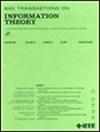基于频率的信道容量:分子浓度的编码信息
IF 2.9
3区 计算机科学
Q3 COMPUTER SCIENCE, INFORMATION SYSTEMS
引用次数: 0
摘要
我们考虑一个分子通道,其中信息被编码为池中分子的频率,其在读取时间的输出是输入频率的带噪声版本,通过从池中替换采样获得。当池中的分子数量受到限制时,我们使用上界和下界来严格表征该通道的容量。我们将这一结果应用于精确定义的短分子状态下的DNA存储通道,并表明即使该通道的容量在技术上为零,它仍然可以实现非常大的信息密度。本文章由计算机程序翻译,如有差异,请以英文原文为准。
Capacity of Frequency-Based Channels: Encoding Information in Molecular Concentrations
We consider a molecular channel, in which messages are encoded into the frequency of molecules in a pool, and whose output during reading time is a noisy version of the input frequencies, obtained by sampling with replacement from the pool. We tightly characterize the capacity of this channel using upper and lower bounds, when the number of molecules in the pool is constrained. We apply this result to the DNA storage channel in a accurately defined short-molecule regime, and show that even though the capacity of this channel is technically zero, it can still achieve very large information density.
求助全文
通过发布文献求助,成功后即可免费获取论文全文。
去求助
来源期刊

IEEE Transactions on Information Theory
工程技术-工程:电子与电气
CiteScore
5.70
自引率
20.00%
发文量
514
审稿时长
12 months
期刊介绍:
The IEEE Transactions on Information Theory is a journal that publishes theoretical and experimental papers concerned with the transmission, processing, and utilization of information. The boundaries of acceptable subject matter are intentionally not sharply delimited. Rather, it is hoped that as the focus of research activity changes, a flexible policy will permit this Transactions to follow suit. Current appropriate topics are best reflected by recent Tables of Contents; they are summarized in the titles of editorial areas that appear on the inside front cover.
 求助内容:
求助内容: 应助结果提醒方式:
应助结果提醒方式:


